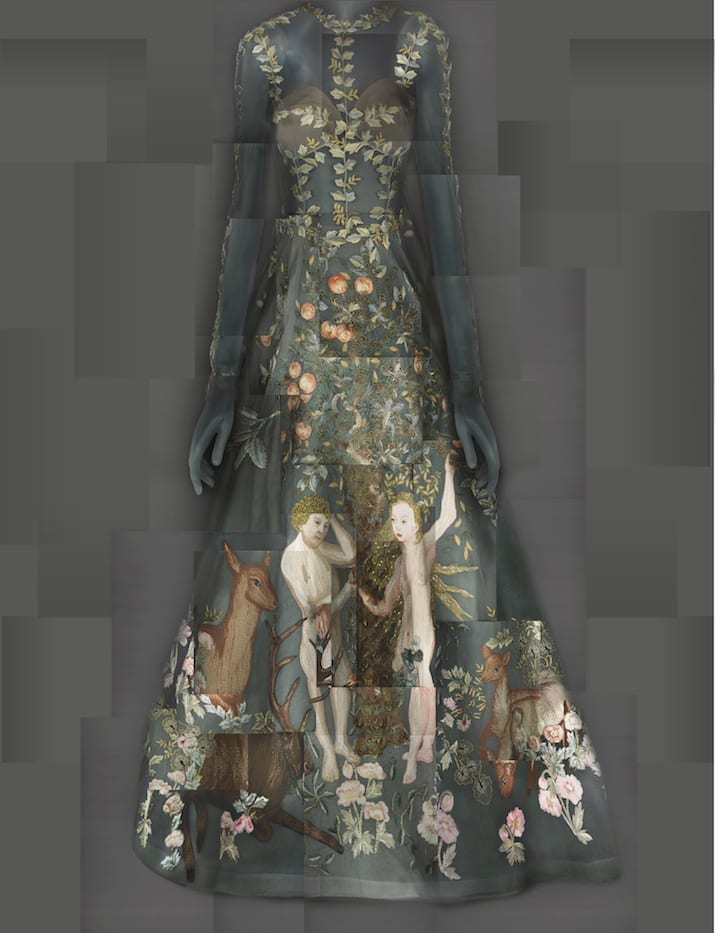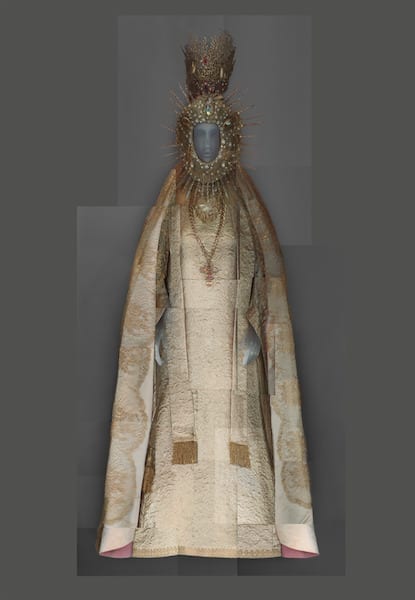The Metropolitan Museum of Art explores the influence of Catholic imagery on fashion in a blockbuster show from the Costume Institute.
By Katie Weisman

Evening dress, Valentino, Spring 2014. (Image: The Metropolitan Museum of Art. Digital composite scan: Katerina Jebb.)

Dolce & Gabbana ensemble, Autumn 2013.
“Fashion and religion have long been intertwined, mutually inspiring and informing one another.”
On May 10, the Heavenly Bodies: Fashion and the Catholic Imagination exhibit opened at The Metropolitan Museum of Art in New York City. The exhibition, spanning two galleries and the Anna Wintour Costume Center at the Met’s Fifth Avenue location in addition to its Cloisters outpost in upper Manhattan, is the Met’s biggest fashion exhibit and the museum’s biggest show to date, making it one of the must-see events of the year.
“Fashion and religion have long been intertwined, mutually inspiring and informing one another,” said Andrew Bolton, Wendy Yu Curator in Charge of The Costume Institute. “Although this relationship has been complex and sometimes contested, it has produced some of the most inventive and innovative creations in the history of fashion.”
The Vatican has loaned more than 40 exceptional ecclesiastical pieces from its collection, most of which have never left the Sistine Chapel sacristy. This includes papal vestments, along with jewelry and other accessories from the 18th to the 21st century, spanning 15 papacies. These items are on display in the Anna Wintour Costume Center. The Vatican previously loaned similarly extraordinary pieces to the Met for The Vatican Collections exhibition in 1983, the museum’s third most-attended show.
Complementing this remarkable selection are the 150 pieces of fashion, mainly women’s wear, displayed in the Byzantine and Medieval Art galleries of the Met Fifth Avenue’s Robert Lehman Wing in addition to The Cloisters, both host to some of the richest collections of Byzantine and medieval art in the world. Bolton noted that the fashion items chosen for the show correspond to specific pieces in the Met’s collections and the hope is that the juxtaposition of the fashion with the art will facilitate contextual connections for viewers. Bolton further explained that the pieces in The Cloisters, exhibited by way of complex digital imaging by artist Katerina Jebb, reflect how designers are inspired by monastic orders.
The house of Versace is one of the main sponsors of the exhibit. Late designer Gianni Versace was often inspired by the Byzantine micro mosaics of San Vitale basilica in Ravenna, Italy, and elsewhere. A gold mesh dress with a large cross designed for his last collection in 1997 is featured in Th e Met show, among other items from his collections. Other big-name designers in Heavenly Bodies include Yves Saint Laurent, Gabrielle “Coco” Chanel, Karl Lagerfeld for Chanel, Jean Paul Gaultier, Azzedine Alaïa and Domenico Dolce and Stefano Gabbana for Dolce & Gabbana. Fashion-forward and new designers are also featured, such as Thom Browne, Laura and Kate Lulleavy for Rodarte, Jun Takahashi for Undercover and Simone Rocha. Finally, there are pieces from the great early-mid 20th-century designers such as Jeanne Lanvin, Madame Grès (Alix Barton), Claire McCardell, Valentina and Madeleine Vionnet.
Fashion has often dabbled with religion and with religious themes. Crosses have enjoyed moments of trendiness outside of traditional religious jewelry. In 1993, Jean Paul Gaultier, inspired by Hassidic Jews he saw in New York, held a show titled “Chic Rabbis” where he appropriated elements of Jewish religious garb into a fashion collection. For his fall-winter 2000 Christian Dior Haute Couture collection, “Freud or Fetish,” designer John Galliano had the character of a priest in full papal-like vestments open the show. Designers have also used fabrics, materials, and finishings inspired by religious decorative arts for their fashion. Heavenly Bodies features, for example, an evening gown, photographed and collaged by Jebb, from Valentino’s spring-summer 2014 collection that reinterprets the 1528 Adam and Eve tapestry by German Renaissance artist Lucas Cranach. And like Versace, Dolce & Gabbana referenced the glimmering Byzantine mosaics in an evening ensemble from fall-winter 2013. Despite the beauty of the fashion items, the show is sure to create a stir due to its religious context.

Statuary vestment for Virgin of El Roíco, ca. 1985.

Evening ensemble, John Galliano, Autumn-Winter.
VISITING TIPS:
Give yourself plenty of time; there is a lot of ground to cover. Special shows at The Met draw huge crowds; arriving earlier or close to opening hours is key. A ticket to The Met is good for three days at all locations, so you don’t need to go to the Fifth Avenue and the Cloisters in one day. For residents of New York, New Jersey, Connecticut, and students, admission is pay as you wish. For all others, admission is $25, $17 for seniors and $12 for students. Children under 12 may visit free of charge. In addition to the Met Fifth Avenue and The Cloisters, The Met Breuer on Madison Avenue showcases modern art.

